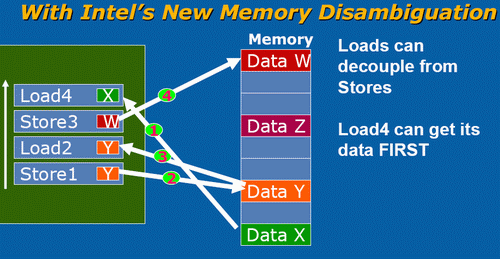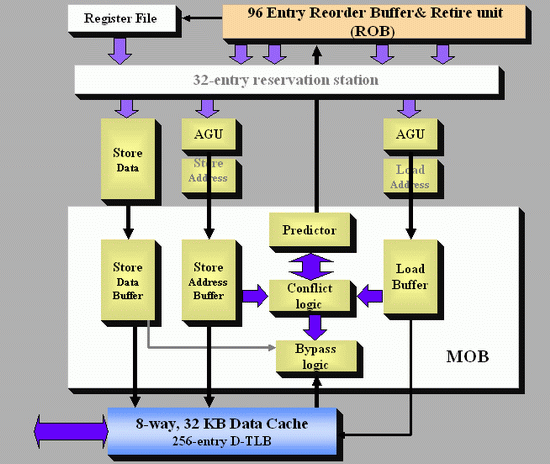Out of Order Loads done right
Since the Pentium Pro, x86 CPUs have been capable of issuing and executing instructions out of order. However, on average one third of the instructions in those reorder buffers could not be reordered easily: we are talking about loads. Moving loads forward can give a very big boost to performance. Instead of loading a piece of data when you need it, it is much more useful to start the load as early as you can. That way, L1 and even L2-cache latencies can be much more easily hidden.This is pretty easy to understand. Imagine having an ALU operation that needs a certain piece of data but that the data is not available in the L1-cache. If the load has been executed many cycles before the ALU operation needs that piece of data, the L2-cache latency is going to have a reduced impact. Of course, you don't want to load a value which is being or will be written to by a previous - following the program/thread order - store. That would mean you are loading an old value, not the up to date one. Check out the picture below.

Load 2 cannot be moved forward, since it has to wait until the first Store is done. Only after Store 1 is done will variable Y have its correct value. However there is no reason why Load 4 cannot move forward. It doesn't have to wait for Store 3 and store 1 to finish. By moving Load 4 forward, you give the load unit more time to get the right operand, as we assume that after load 4 a calculation with operand Y will happen.
Currently, CPUs will generally delay load 4 when a store is in flight (active). The problem is the address to which the stores will write has yet to be calculated. To be more precise, the memory addresses are still unknown during reordering and scheduling. When a Load micro-op enters the ROB, the memory addresses of previous stores (from the program order) are not known until they pass the AGU (Address Generation Units).
However, the risk that a load will load a value out of an address that is being written to by a store that has yet to be finished is pretty small (1-2%). That is why Jack Doweck of the Core development team decided to allow Loads to go ahead of previous stores, assuming that the load will not be loading information that will be updated by that preceding store. To avoid that the assumption was wrong, a predictor is used to help. The dynamic alias predictor tries to predict whether or not a previous store will write to the same address as the address from which the load - that you want to execute earlier, thus out of order - will load its data.
Based on Jack Doweck's comments and a study of Intel's previous P6 and P-M architectures I drew up the scheme below. Be warned that this is not the official Intel diagram.

The predictor gives the ReOrder Buffer (ROB) the permission to move a load ahead of a store or not. After the Load has been moved ahead and executed, the conflict logic scans the store buffer located in the Memory reOrder Buffer (MOB) to see if any of the stores which were located before the load (following program order) have written to the address of the out of order load. If so, the load must be redone, and the misprediction penalty is about 20 lost cycles. (Note that the branch misprediction penalty is also about 20 cycles). Worst case, the new dynamic alias predictor may slightly reduce performance, but realistically it's four steps forward, one step back, resulting in a net performance boost.
Determining whether a load and a store share the same address is called memory disambiguation. Allowing loads to move ahead of stores gives a big performance boost. In some snippets of benchmarking code, Intel saw up to a 40% performance boost, solely the result of the more flexible way Loads get reordered. It is pretty clear that we won't see this in most real applications, but it is nevertheless impressive and it should show tangible (10-20%) performance boosts together with the fast L2 and L1 cache.
Let us not forget that loads are probably the most important instructions of all. Not only are loads about one third of the micro-ops that are in flight in a x86 CPU, but they can also cause costly stalls when a load needs to go to the L2 cache (or worse, system memory). So how does this super flexible reordering of loads compare with other architectures?

The P6 and P-M could already reorder Loads pretty good. They could move one Load before other Loads, as well as before Stores which have no unknown addresses or addresses which do not reference the same address as the load. In contrast, the Athlon 64 can only move loads before independent ALU operations (ADD etc.). Loads cannot be moved ahead much at all to minimize the effect of a cache miss, and other loads cannot be used to keep the CPU busy if a load has to wait for a store to finish. This means that the Athlon 64 processor is severely limited when it comes to reorder code.
This is probably one of the most important reasons why the Athlon 64 does not outperform the P-M in gaming and integer workloads despite having a lower latency memory system and more integer execution sources. Integer workloads tend to jump around in memory, and have many unknown addresses which must be calculated first. It is less important for FP intensive loads, which is also one of the reasons why the Athlon 64 had no problem with Dothan in this kind of workload. FP workloads access the memory in a much more regular fashion.
Once Loads and Stores are in the queues of Load/Store units, the Athlon's L/S unit allows Loads to bypass Stores, except of course when the load would bypass a store to the same address. Unfortunately, by then the Loads are already out of the ICU and cannot be used to fill the holes that dependencies and cache misses make. You could say that the Athlon (64) has some Load/Store reordering but it's much later in the pipeline and is less flexible than the P6, P-M, and Core architectures.










87 Comments
View All Comments
BigT383 - Monday, May 1, 2006 - link
I loved this article. It's due to articles like these that I've been reading Anandtech since before the days of the K6-2.PandaBear - Monday, May 1, 2006 - link
Of course Core should be better than K8, it better be.The only thing I am concerned about the Core architecture is with all these additional stuff, it will probably cost a lot to make, not just the CPU, but the MB, chipset, will also be expensive with the additional high speed circuitry. That means it will probably cost more.
K8 has been 5 years old and it is not bad standing against the latest and greatest. If AMD have something in the pipeline that will be the next monster CPU, it will be great. What I am concern about AMD is whether they can keep their yield up and have enough $ left behind to design K9 and beyond. Don't just sit there and lose the momentum they gain.
saratoga - Monday, May 1, 2006 - link
Core is a pretty conservative design with a pretty small die for a new core. It should be very economical to produce. Probably more so then the chips its replaceing.IntelUser2000 - Monday, May 1, 2006 - link
Not really. Not many expected that Intel will do more than increasing clock speeds and cache sizes since that's what they have been doing that since Pentium II.
http://www.reghardware.co.uk/2006/04/05/intel_conr...">http://www.reghardware.co.uk/2006/04/05/intel_conr...
The ASP went down. $530 for the fastest mainstream Conroe is rather good.
zsdersw - Monday, May 1, 2006 - link
The pricing put out by Intel suggests that Core will be priced very aggressively. I can't see the 975 chipset costing significantly more than it does now when Core is released.The fact that Core is going to be built on Intel's 65nm process means that the "additional stuff" you refer to will cost less than it would if built on the 90nm process. And the die size probably grew a little, but not enough to offset the cost gains from the 65nm process.
xtremejack - Monday, May 1, 2006 - link
K8 is only 3 years old. Didn't AMD celebrate their 3rd anniversary of Opteron a few days ago.Griswold - Thursday, May 4, 2006 - link
Its been sold for 3 years, but clearly the design is "a few days" older than that.evident - Monday, May 1, 2006 - link
as a junior computer engineer at villanova university, i found this article to be really informative and an awesome read. it's really cool to see the differences between these CPU architectures and shows that they are actually teaching me something useful!PeteRoy - Monday, May 1, 2006 - link
How can you say Netburst wasn't a huge success?I think Netburst was a success when it was launched and it should have died sooner, but it was good for it time and now it will be replaced.
JarredWalton - Monday, May 1, 2006 - link
NetBurst started at 1.5 GHz basically and topped out at 3.8 GHz. Compared to previous architectures, that's pretty tame. P6 went from 150 MHz to 1.26 GHz (and beyond if you want to count P-M). Success monetarily vs. success as an overall design are two different things, and clearly NetBurst ran into trouble. Where are the 5 GHz+ Tejas chips? Waiting somewhere beyond the thermal even horizon.... :)